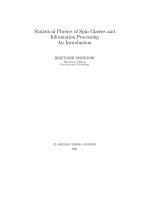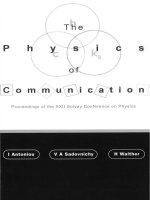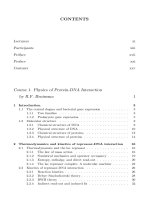Physics of centrifugal pumps cavitation DK presentation VI 02 2012
Bạn đang xem bản rút gọn của tài liệu. Xem và tải ngay bản đầy đủ của tài liệu tại đây (4.52 MB, 51 trang )
Physics
C t if
l Pumps
P
Of Centrifugal
&
Cavitation
Case Histories
Presented By:
James David Kesler
p
g
Sales/Operations
Manager
Technical Associates
1230 West Morehead Street, Suite 400
Charlotte NC 28208
Charlotte,
704-333-9011
Are Pumps Important?
PUMPS
Are Critical
to our life on this Planet?
How Long Would The World
We Know Continue If
All Pumps Stopped Working?
PUMPS ARE
CRITICAL
Introduction
Radial Flow Centrifugal Pumps
Centrifugal Pumps are simple machines. A
centrifugal
g pump
p p moves a liquid
q
against
g
gravity,
g
y,
pressure forces and system friction. They use
centrifugal force generated by a rotating
impeller/shaft to move a liquid
liquid.
The shaft/impeller accelerates (throws) the fluid
t
d toward
t
d the
th tip
ti off the
th blades
bl d att the
th
outward
periphery of the impeller. At this point the fluid is
g at a higher
g
y than at the impeller
p
discharged
velocity
inlet. The higher the velocity, the higher the feet of
head the pump can generate. This process
requires energy (Pump Water Horsepower)
Horsepower).
Pumps Require Energy
Pump Water HP = GPM X 8.33 X Total Head
33,000
Pump Water HP = GPM X Total Head
3960
Pump Motor HP = GPM X Total Head
3960 X Motor/Pump
p Eff.(70%-75%)
(
)
Motor Amps(3-Phase) = BHP X 1.732
Voltage X % Motor Eff.
Eff
Single Phase =
BHP x 746
V lt
Voltage
X %Motor
%M t Eff.
Eff
Centrifugal Pumps Convert Mechanical Energy
(Shaft Torque ) Into Kinetic Energy
(Acceleration/Velocity) and Potential Energy
(Pressure (psi) using centrifugal force.
Shaft Torque (Ft. Pounds) = M otor BHP X 5350
RPM
The fluid’s velocity reduces as it exits the
impeller and enters the pump casing (volute).
A portion of the Kinetic Energy (velocity) of the
moving fluid is transformed into pressure(psi).
Pressure is a force that tries to burst the pipe,
t k or pump h
tank
housing.
i
(1 psi = 2.31 feet of head)
Pressure
PSI
Available Head ((Theoretical head)) that a
centrifugal pump impeller can develop at a
given operating speed can be calculated using
the law of falling bodies
bodies.
Available Head ((H)) = V2
2g
H = height of fluid (lift) or head in feet that can
be developed by the velocity of a fluid as
it exits the pump impeller.
V = velocity of the moving fluid in fps leaving
the tip of the impeller vanes.
g = acceleration of gravity (32.2ft/sec2 )
PUMP IMPELLER CALCULATIONS
IImpeller
ll Dia.
Di
=
(inches)
Example:
E
l
H = 100 ft head
2g= 64.4 ft/sec2
1800 RPM Impeller
p
(
H x 2g
229 2
229.2
RPM of the impeller
100 64.4 ) 229.2
10.22 in diam.
1800
Sh t t Technical
Shortcut
T h i l Tip:
Ti
Pumps operating at 1800 RPM will develop a theoretical
head (Total) approximately equal to the impeller diameter
(i h ) squared.
(inches)
d
Example:
A pump with an impeller 12
12” in Dia
Dia. @ 1800 RPM will
develop 144 ft of Total Head
Rotation of the p
pump’s
accelerates the
p impeller
p
fluid as it passes through the impeller. This
acceleration produces the velocity and pressure
required to develop a certain head in feet (doing
the work). Like the old time bucket brigade
fighting a fire. Each impeller section (between the
vanes)) th
throws outt a “bucket”
“b k t” off water.
t
Pressure pulses at
blade p
pass
frequency (BPF)
Cut water
5 Blade impeller
5-Blade
Fluid comes out like
“Buckets of water”.
Discharge pressure X 2.31
equals Total Discharge
Head
PUMP SHUTOFF HEAD
The Pump cannot raise
the fluid above a certain
point (Pump Shutoff Head)
Pump Shutoff Head
Theoretical Head
((Available Total Head))
developed by a pump is
based on the tip speed
of the impeller.
Centrifugal Pump impeller
Pump Shutoff Head
The Pump cannot raise the
fluid above a certain point
(Pump Shutoff Head)
Theoretical Head
(Available Total Head)
Developed by a pump is
based on the tip speed
of the impeller.
Centrifugal Pump Impeller
Centrifugal Pump And Piping Vibration
WHAT IS VIBRATION?
Vibration:
Webster’s New World Dictionary defines Vibration
as “to swing back and forth; to oscillate”
Vibration (Forced) is caused by a Forcing
Function or pulsating motion of a machine part
or rotating
t ti componentt (Pump
(P
Impeller
I
ll or fluid
fl id
flow) that causes the machine or piping to
g
place
p
of rest.
move/oscillate from it’s original
Forcing Frequency:
The frequency at which a machine is forced to
vibrate by a Forcing Function or functions.
Vibration Amplitude:
The magnitude or size of the vibration
movement (Displacement) indicating severity.
Standard Units – Displacement
Vibration Amplitude
is p
proportional
p
to
~
Dynamic Force
Dynamic Resistance
Dynamic Force:
A physical force or energy that causes
acceleration.
Dynamic Resistance
An opposing or retarding force that resists
movement generated by a dynamic force such as
mass/stiffness or arrangement.
Terms:
Velocity (V):
The amount of fluid flowing past a point in a given
time. Flow velocity in a pipe: V = .4085 gpm
d
Velocity
y Head ((hv)):
The vertical distance a body has to fall to reach
the velocity V. This is the static head or pressure
needed to cause a given velocity.
velocity
hv = V2
hv = .00259 (gpm)2
2g
d4
Total Static Head (hts):
The vertical distance between the open end of
the discharge and the inlet (suction) line.
Terms:
Friction Head ((hf)):
The resistance to flow in a system (piping)
measured in terms of ft of liquid (Head).
Net Positive Suction head Available (NPSHa):
The available head in ft available at the suction
inlet of the pump.
Net Positive Suction Head Required (NPSHr):
The pump manufacturer will supply this with
the pump curve.
Total Discharge (Dynamic) Head (TDH):
The pressure reading at the pump discharge
converted to head (PSI x 2.31)plus the velocity head
at the point where the gauge is attached.
Total Head (H):
Total Discharge Head minus the total suction head
Cavitation:
Webster s New World Dictionary defines
Webster’s
Cavitation as “the creation of partial
vacuums in a liquid caused by a high speed
solid
lid object
bj
(impeller).
(i
ll ) The
Th pitting
i i & wearing
i
away of solid objects by the collapse of the
) the surrounding
g liquid”.
q
vacuums ((bubbles)in
Forcing Functions Generated By
Forces))
Pumps
p (Dynamic
( y
“Forcing Functions” are created by the action of machine
components such as Pump Blade Pass Frequency (BPF)
occurring at a repetitive rate or periodic rate
rate. This is
usually expressed in (Hz) or cycles per minute (CPM), or
multiples of running speed. The energy (Dynamic Force)
contained per pressure pulse is inversely proportional to
the number of pump impeller blades.
Pressure
pulses at blade
pass frequency
Cutwater
5-Blade
impeller
Pulses from the
impeller blades
create a forcing
function at (BPF).
Cutwater
3-Blade
impeller
Notes:
A “Forcing Frequency” is created by the action of a
forcing
o c g function
u ct o of
o a machine
ac e component
co po e t (Pump
( u p
Blade Pass Frequency BPF) or system occurring at a
repetitive rate or periodic event. This is usually
expressed in (Hz) or cycles per minute (CPM), or
multiples of running speed.
Pulses from the
impeller blades
create a forcing
f
function
ti
3-Blade
impeller
800 RPM Pump
1100 RPM Pump 1400 RPM Pump
BEAT FREQUENCY CAN DEVELOP
BETWEEN PUMPS OR PRESSURE PULSES
How Healthy Are Your Pumps?
1. What do you see in the vibration spectra?
2. Is the pump running quiet or noisy? Does it sound like rocks are
being pumped?
3. Are the pressures correct and the gauges steady?
4. Are your check valves and piping stable or bouncing and vibrating?
5. Is the amperage
p g on the motor correct or fluctuating?
g
Swing Check Valve & Pressure Gauge Bouncing
Indicates Flow Pulsation /Cavitation
PUMP SYSTEM PROBLEMS?
PIPING
PUMP DISCHARGE PIPING:
1. Clogged filters, Clogged pipes, Valves closed
2 Discharge piping to small for the flow required
2.
3. Poor piping design, sharp turns and obstructions
4. Incorrect Pump Head calculations.
5. The Pump is operating at or near shutoff head.
SYMPTOMS:
1. Low or fluctuating flow rate.
2. High discharge pressure or pressure pulsations.
(Pressure gauge fluctuate or Check valve arm
bouncing)
3. The pump sounds like it has rocks or marbles
rolling around inside.
SUCTION SIDE PROBLEMS:
1 S
i Line
Li Too
T Long
L
(L
NPSHA)
1.
Suction
(Low
NPSHA).
2. Suction Line clogged or too small.
3 Suction filter/screen clogged
3.
clogged.
4. Suction Lift too High
5. Poor
5
oo inlet
et piping
p p g design
des g
Symptoms:
The Pump Sounds Like It’s Pumping Rocks,
Low or pulsing discharge pressure (pressure
gauge
g
g fluctuates))
CAVITATION…..MOST LIKELY VAPORIZATION
TYPE (Classic Type)
CASE STUDY
H i
t l End
E d Suction
S ti
Horizontal
Centrifugal Pumps:
CAVATION
PROBLEMS
Presented By: James David Kesler
Sales/Operations Manager
Technical Associates of Charlotte,
P.C.
February 17, 2012
www.technicalassociates.net
@
DEFINING THE PROBLEM
Background:
Four (4) new 125 HP Horizontal End Suction VFD
(variable speed 1075-1790 RPM) Centrifugal
pumps were installed to replaced older fixed
speed pumps that had cavitation issues.
The pumps are used during high flow conditions
and are pumping waste water (sewer).
The pumps were installed using the existing
piping check valves and components.
The pumps are VFD driven with 14.5” Diameter
Impellers (Capable of 210 ft head at 1790 RPM).
Th pumps are designed
d i
d for
f solids
lid handling.
h dli
The
24
4. The New Pumps were factory tested using
clean water for acceptance at all running
speeds and heads. 1024 GPM @ 208 ft head
was the design selection.
PERFORMANCE TEST
FLOW GPM
1790 RPM
1.
2
2.
3.
4.
5.
6.
7.
6
662
1094
1104
1443
1950
2341
Hdiff Selected Pump has
14 5" Impeller
(FT) 14.5"
247.4
221.1
221 1
208.0
208.5
197.2
181.6
167.4
1024 GPM @
208 ft head
1790 RPM
CLEAN WATER









